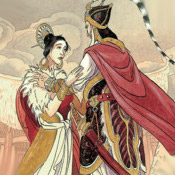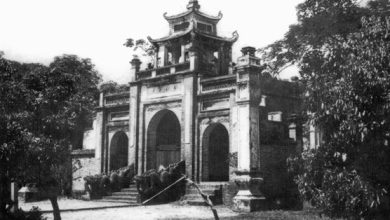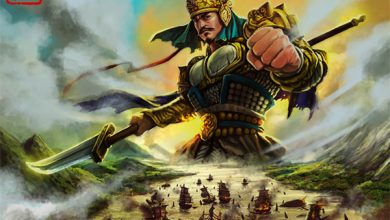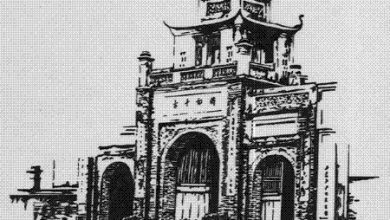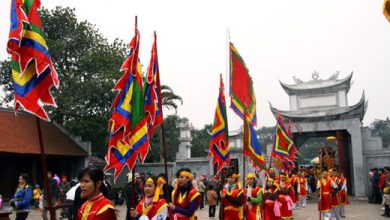King Ngo Quyen and Co Loa Royal Capital
Ngo Quyen was born in Mau Ngo year (898), 5th year of Can Ninh reign, in the local influential family in Duong Lam commune, Son Tay town, Hanoi.
He was the son of Ngo Man, an influential mandarin official in Duong Lam commune, his Ngo surname is a local influential and patrician family.
The legend has it that, when Ngo Quyen was born, he had three beauty spots on his back. A physiognomist saw and guessed that he can become a lord-over of the region, hence he was named Quyen. Ngo Quyen look handsome, “lightning-bright eyes, leisurely walk like a tiger”, “he had unrivalled health”.
Ngo Quyen’s boyhood was also the stormy period of Duong’s domination in An Nam. An Nam mandarin increasingly proved incapable of controlling the local forces as well as the external forces. Nam Chieu people had onslaught with Giao Chau from the year 858 to 866. After disturbance of An Su (755 – 763) and especially revolt of Hoang Sao (874-884), Duong dynasty have to deal with victims of division into feudal realms, the control of the central mandarin for An Nam is increasingly weaker. The power of the mandarin was dispersed into small areas, so it appeared the village notables who played an increasingly important role in the governance apparatus. Therefore, Khuc family, Hong Chau village notable have established a self-control mandarin in An Nam easily and without much disturbance in the year 905. Khuc family’s forces was weak, confrontative and defeated by the invasion of Nam Han dynasty. But Nam Han’s dominance was not sustainable: in 931, Duong family’s forces in Ai Chau defeated Nam Han dynasty’s mandarin officials as Ly Tien, Tran Bao at the foot of Dai La citadel, Duong Dinh Nghe became a governor of self-control Vietnamese’s mandarin.
Domination of Duong family’s force in Dai La was supported by many other local forces, including Ngo family of Ngo Quyen.
The history described that Ngo Quyen was a talent hero, “having wisdom and courage”. After marriage with Duong Dinh Nghe’s daughter whose name is Duong Thi, Duong Tam Kha’s younger sister, Ngo Quyen became a general and son-in-law of Duong Dinh Nghe, trusted and assigned by the governor to manage Ai Chau, basic land of Duong family in the year 932.
In 937, Kieu Cong Tien, village notable of Phong Chau, murdered Duong Dinh Nghe and became a final Tinh Hai Quan governor in the Self-control period. But the new governor had not firm political support. His scramble for power was protested by many local forces and even Kieu family’s internal force was also separated seriously. In segregation, Kieu Cong Tien hastily asked Nam Han dynasty for help.
Ngo Quyen and His Historical Victory at Bach Dang river
On days of the Winter of Mau Tuat year (938), from Ai Chau, Ngo Quyen led his troops to the North to punish the traitor Kieu Cong Tien.
According to the stories of the gods, the legend from generation to generation among the common people and Duong surname families in Rang village (Duong Xa commune, Thieu Yen district, Thanh Hoa province), Duong Tam Kha (Duong Dinh Nghe’s son) and Do Canh Thac, under Ngo Quyen’s direction, led the troops to attack Dai La citadel, killed Kieu Cong Tien.
When internal strife finished, Ngo Quyen went to the citadel to meet with the generals to discuss the plans against invasion. Dai La citadel became the nerve- center of the war against Nam Han for the second time. Heroes from the four direction led their troops to Dai La under the righteous flag of national hero Ngo Quyen. Here, an ingenious fight and victorious plan was discussed and approved by Ngo Quyen and the generals. In a meeting, Ngo Quyen, with confidence and self-control, expressed his opinion as follows:
“Hoang Thao is such a foolish child, leading his troops from the far land, his soldiers were still tired, eventually they completely feared when they heard that Cong Tien was killed and there were no information about the situations happened right here. Our troops are strong, the enemy is weak, we can surely victory this war. But they have an advantage at warships, if we don’t plan our defend first, we don’t know who will control the battle. If we order to place the iron-headed stakes under the water of the sea gate, their ships will follow the tide of sea into the poles, then we can easily dominate them without letting any ships of their escaped, it is the best plan”. The plan and selection of the battlefield for the “strategic battle” has been decided. The Generals and officers were happy and believed the victory. Then, Ngo Quyen and the headquarter temporarily left Dai La citadel, led the troops to the northeast coastal region to prepare the battlefield for the battle with Nam Han enemy.
According to the stories of the gods and the legend from generation to generation among the common people, villages and over 30 temples to Ngo Quyen and the generals defeating Nam Han enemy have been discovered, Ngo Quyen’s garrison was from villages Binh Kieu, Ha Doan to Luong Khe, the general headquarter located at hamlets Luong Sam, Gia Vien (all under An Hai district, Hai Phong).
Formerly, most troops of Ngo Quyen were Ai Chau people, where he governed. Upon Nam Han enemy’s aggression, these troops were added and strengthened quickly. People everywhere enthusiastically brought weapons, warships to join and support the troops. Only a Gia Vien hamlet where Ngo Quyen located the general headquarters also had some tens of young men under the command of Dao Nhuan and Nguyen Tat To voluntarily joined in the army.
River gate region and upstream region of Bach Dang river selected by Ngo Quyen to be a decisive battle.
Bach Dang river is gateway in the Northwest and an important traffic from the Eastern sea to Viet’s land. Following Nam Trieu gateway into Bach Dang, the enemy could go to Co Loa citadel or Dai La citadel by river way. Bach Dang river flows through a rugged and mountainous area, there are many tributaries flowing into. Bach Dang river’s downstream is low, is affected strongly by tide. Tide rises from midnight to the morning. Seagate is vast, its water spreads on both sides of more than 2km. Near noon, the tide pulls up strongly and runs very fast.
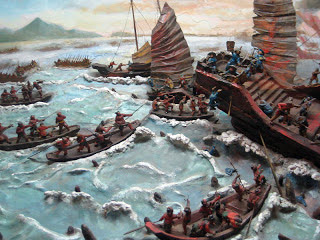 At the end of 938. It was cold, the northeastern wind flooded back, it rained for half-month. In those days, as planned by the Ngo Quyen, our troops and people transported wood, planted stakes under the cold rain. Thousands of ironwood, bassia with top to be sharpened and tipped with iron were brought and planted at both riversides (current Nam Trieu river gate) into certain long and firm lines, the stakes’ top was in the direction of the source.
At the end of 938. It was cold, the northeastern wind flooded back, it rained for half-month. In those days, as planned by the Ngo Quyen, our troops and people transported wood, planted stakes under the cold rain. Thousands of ironwood, bassia with top to be sharpened and tipped with iron were brought and planted at both riversides (current Nam Trieu river gate) into certain long and firm lines, the stakes’ top was in the direction of the source.
As the tide was down, the stake lines were exposed. In the early morning, vast river water, the big ships could swim at both sides easily. Stake battlefield was carried out very urgently and all works were completed within only more than one month. As expected by Ngo Quyen, the battle would take place inside the stake field. The General Duong Tam Kha (Duong Dinh Nghe’s son) commanded the troops on the left bank, Ngo Xuong Ngap (Ngo Quyen’s eldest son) and Do Canh Thac commanded the road troops on the right bank, ambushed, coordinated with naval force to attack the enemy and ready to kill some enemies running the ashore.
At not far distance from the border it was a strong naval force that was ambushed and commanded by Ngo Quyen to block right the ahead way of the enemy, and he waited until the tide was down then ordered his troops to attack the enemy’s ship-troops.
When the battlefield has just completed, Nam Han warship from Guangdong arrived. The battle took place as planned and expected by Ngo Quyen.
Hoang Thao’s all big warships that have just crossed the sea to Bach Dang river gate were driven into our planned battlefield and they were destroyed in the short term. The enemy’s entire warships were sunk into the sea, most of the enemy was destroyed, the commander Luu Hoang Thao was killed in this battle.
The quick victory of the battle at Bach Dang river made the King Nam Han, Luu Cung, garrisoning troops near the border to not timely support his son. The history has written that: “the King Han wept openly, collected remaining troops and then retreated “. Bach Dang victory under Ngo Quyen’s dynasty was a brilliant development of the Vietnamese military art.
In condition that our troops and the enemy’s troops were not different much. Ngo Quyen took advantage of the weather, topography to create strength to attack the enemy and won the victory by one naval battle on the river.
To praise the national hero Ngo Quyen, the historian Le Van Huu wrote: “Tien Ngo Vuong could take the newly raised soldiers of Viet to defeat thousand troops of Luu Hoang Thao, created the country and claimed himself King, made the Northern feared as they didn’t want to come again. We could say this is a wrath to ease the people, great tactics, good combat too”
The Victory at Bach Dang in 938 is the victorious final of Vietnam in the fighting the Chinese’s domination and assimilation to retake the full independence of Vietnamese people. That great victory defeated completely Nam Han’s invading plan, created basis so that Ngo Quyen developed the self-control mandarin of Khuc family, Duong family into the independent Mandarin, and ended 1000 years of the Chinese’s domination.
King Ngo Quyen and Co Loa Royal Capital
By resounding victory on Bach Dang River, our nation does not end the domination over thousand years of the North, but also facilitates to build a fully independent nation.
Ngo Quyen decided to give the Item porcelain, self-proclaimed king, set up an independent kingdom properly. Select the old capital of the Au Lac is Loa as Viet’s capital, the King Ngo Quyen wanted to follow the tradition of the Hung Kings, the King Thuc.
The historian Le Van Huu under Tran’s dynasty upheld this idea of the King Ngo Quyen when he wrote that “our orthodox Viet has been resumed”. In Co Loa royal capital, the King Ngo Quyen initially held a independent dynasty: “order the position hundreds, give regulations on the mandarin’s costume, can see the scale of the king”. His wife’s surname is Duong, Duong Dinh Nghe’s daughter, was inaugurated as the queen. Although Ngo Vuong’s dynasty was still simple, but was built under the institutions of a completely independent dynasty.
The minister who has in the war against the Southern Han were knighted, feudatory level as Pham Lenh Cong was granted land in the South of Sach Giang (Nam Sach, Hai Duong).
The King Ngo set up the capital in Co Loa for 6 years (939 – 944). In six short years it’s sure that the Ngo’s dynasty still did not construct additionally much anything in Co Loa old royal capital. Archaeologists found only pieces to fix up at Ngo Quyen old abandoned platform into Thuc An Duong Vuong
The archaeologists only found sections of the royal capital to be repaired and embanked at Ngo Quyen’s dynasty on the basis of deserted old royal capital of Thuc An Duong Vuong.
The folk legend of Co Loa told that when setting up the capital here, he commanded to plant a banian tree in the front of My Chau small temple and dig a well at the temple. The people of this region also transmitted orally: “thousand year banian tree”, “Well of Ngo’ dynasty”.
With the King Ngo’s setting up the capital in Co Loa, Hanoi area was restored as the political central position of the country in early independent renaissance after more than thousand years of the period of domination.
Ngo Quyen died in 944, Ngo Quyen died in 944, in his 47 years. At Duong Lam commune (Son Tay town, Ha Tay) where Ngo Quyen communal house and royal tomb. Many precious displayed objects such as stone axe, neolithic relics, Bach Dang wooden stake are maintained in the traditional house of Duong Lam commune. Nearby there are deep ditches, the legend has it that it was lotus lakes where Ngo Quyen and his childhood friends played a game of naval battle.
In Hai Phong city, next to Bach Dang historical river, there are also temples and communal house where Ngo Quyen is worshiped. In Hang Kenh communal house – magnificent communal house in Hai Phong was constructed in 1718 – has large parallel sentences with Han script line:
“Vuong nghiep khoi nghiep Loa Thanh, truong bien thanh su.
Chien cong luu Dang thuy, cong moc hong an”, that means: “Royalty was started from Co Loa Citadel and maintained forever in the history. This victory saved on Bach Dang river, including the blessing of the species”./.


